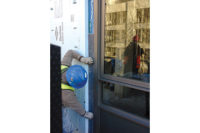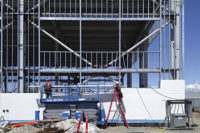Several years ago while working on a Colorado shopping mall I was surprised to see the Design Development drawings I was reviewing indicated insulation at the low-sloped roofing assembly as a mere R-11. The climatein this part of Colorado, as with most of Colorado, is cold—really cold. Way colder than the winters I am used to in the Pacific Northwest. In my neck of the woods, at that time, the R-value requirement for roofing assemblies was nearly three times what I was seeing in the shopping mall drawings. I assumed a huge error had been made, and I assumed incorrectly. At that time, R-11 was all that was required to meet the energy code requirements.
Fast forward to 2012, are things any different in Colorado? Yes, they are! Almost every state in the US has adopted (including Colorado), in some form or another, the International Energy Conservation Code. For a snapshot of Statewide International Code adoption, go to www.iccsafe.org/gr/Documents/stateadoptions.pdf.
ENFORCING ENERGY CODES
Now all buildings will have the proper amount of insulation in walls and roofs, good glazing u-values, and efficient mechanical equipment, right? Unfortunately, no. Working on a project very near the mall in Colorado recently, I helped the team come up with a code-required exterior wall assembly, with continuous insulation creating a thermal break between the cladding and the building. The team wondered how an adjacent building under construction was designed (and now being built) without this required insulation? We got it right, but clearly others still haven’t, without any consequence, and this is a huge problem—lack of enforcement. All the talk about energy efficiency, all of the work being done with energy conservation codes, statewide energy code adoption is useless without enforcement.
REASONS FOR FOW COMPLIANCE
A Northeast Energy Efficiency Partnership’s paper about the use of third party energy code inspections found a very small percentage of buildings subject to compliance with energy codes, actually complied (a mere 16 percent in the State of Maine in 2009).
The paper provides the following reasons for low compliance:
Funding: Municipalities suffer from chronic underfunding with respect to most of their required functions, including code implementation, administration and enforcement. As a result, too few code officials (either plan checkers or inspectors) exist in relation to the amount of construction needing to be reviewed, permitted, inspected, and approved for occupancy.
Priorities: Given the limited time to check and inspect construction, officials must prioritize. Consequently, officials deal with life safety and public health issues (such as structural, fire and sanitation) first often leaving little time for review of energy related items.
Training: Code officials do not receive sufficient training on energy code issues in comparison with other aspects of the code such as structural or fire codes.
Lack of Awareness: Architects, engineers, contractors, builders and others may not be fully aware of the code and its requirements.
First Cost versus Life-Cycle Cost: Owners and developers, concerned with first cost and wanting to get buildings constructed in a timely manner to generate income may be less adamant on energy code compliance.
Lending Institutions: Lenders may not send appropriate messages about the importance of energy code compliance and the consequent impact of monthly costs when reviewing loan applications for construction or for purchase of new buildings.
ENERGY EFFICIENCY BENCHMARKING
Adoption of strict energy efficiency codes hasn’t helped much. LEED certainly hasn’t either. What will, then? How about shame through public disclosure? New York City, under a 2009 law intended to help reduce greenhouse gas emissions by 30 percent from 2005 levels by 2030, and just released its first annual report on building’s actual energy use. The law requires public disclosure of commercial and multifamily residential buildings over 50,000 GSF to report actual building energy use intensity, carbon emissions and Energy Star scores. Two of the most interesting key findings are: newer office buildings use more energy per square foot than older ones, and smaller multifamily buildings are more energy intensive than larger ones. One of the key recommendations made for future reports is that utility data be automatically uploaded to a database.
New York City is not the only jurisdiction with energy benchmarking laws on the books. Seattle, San Francisco, Austin and the District of Columbia as well as the States of California and Washington have passed building energy benchmarking laws.
ENERGY EFFICIENCY DATA MINING—BUILDING BY BUILDING
The NYC Benchmarking Report provides an excellent overview of energy use in buildings covered in the report, but does not provide individual buildings’ energy efficiency data. A startup company called Honest Buildings, however, is working with New York to post each buildings energy efficient data on a publicly accessible website www.honestbuildings.com. The website currently has a large database of buildings in New York, Seattle and San Francisco. After registering for free, the site can be searched by property address, building type, or architect—any type of information provided by each listing.
Although shaming building owners into greener buildings is one of the benefits of this sort of public disclosure, it is not the company’s main goal. Instead, the company is focused on a built-environment equivalent to LinkedIn, providing commercial properties with an online networking exposure. It’s designed to match building industry professionals with owners looking for their unique services, the building data acting as resumes or curriculum vitae. A for-profit premium subscription portion of the site will be marketed and sold to these professionals.
CONCLUSION
With such a wealth of information available to the public, it will be interesting to see how it will be used within the industry. No longer will owners and architects be able to easily brag about their green buildings, if those buildings are publicly reporting terrible energy efficiency. LEED will no longer be able to claim that its certified buildings preform any better than equivalent non-certified buildings, if the newly available data does not match the claim. Design professionals that consistently deliver energy efficient buildings to their clients, illustrated in the available data, might start to see their share of work increase, and that of their competitors decrease. Exciting stuff! It’s about time. W&C







Report Abusive Comment